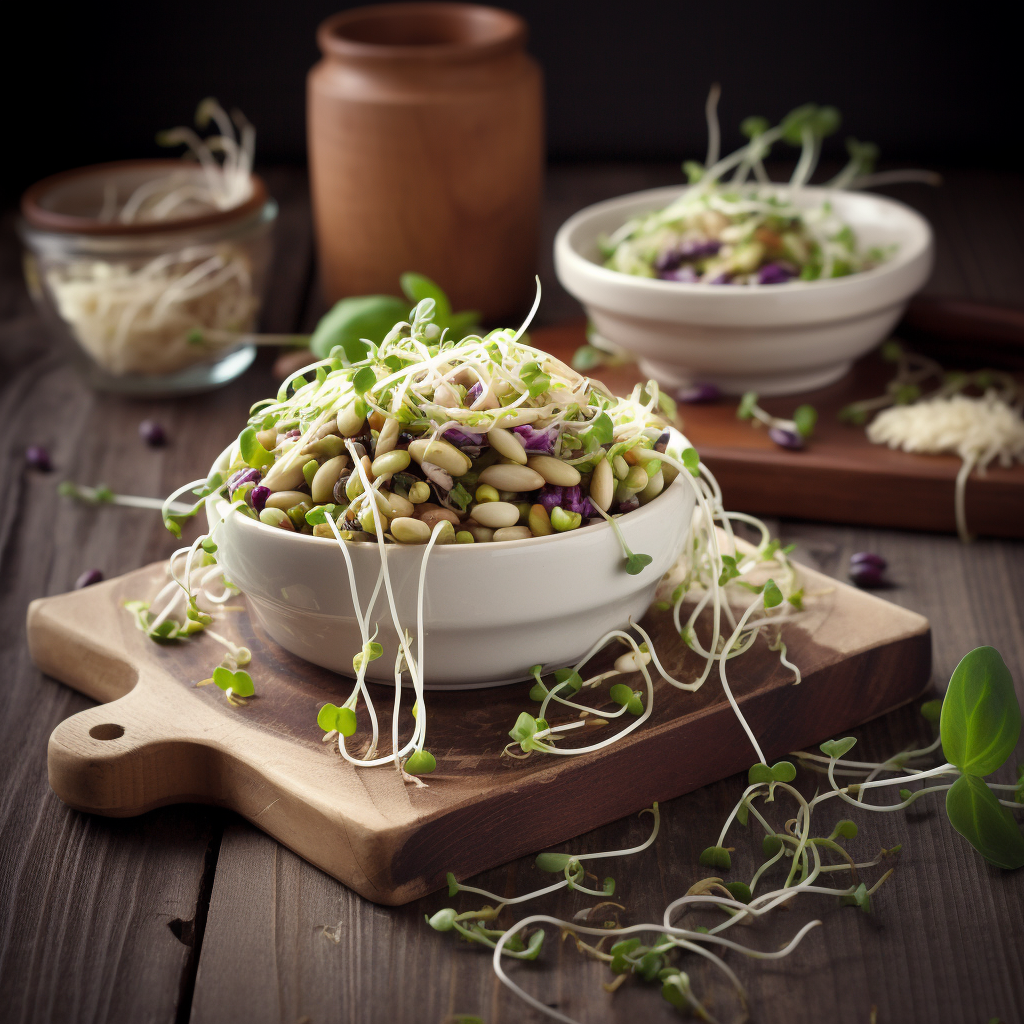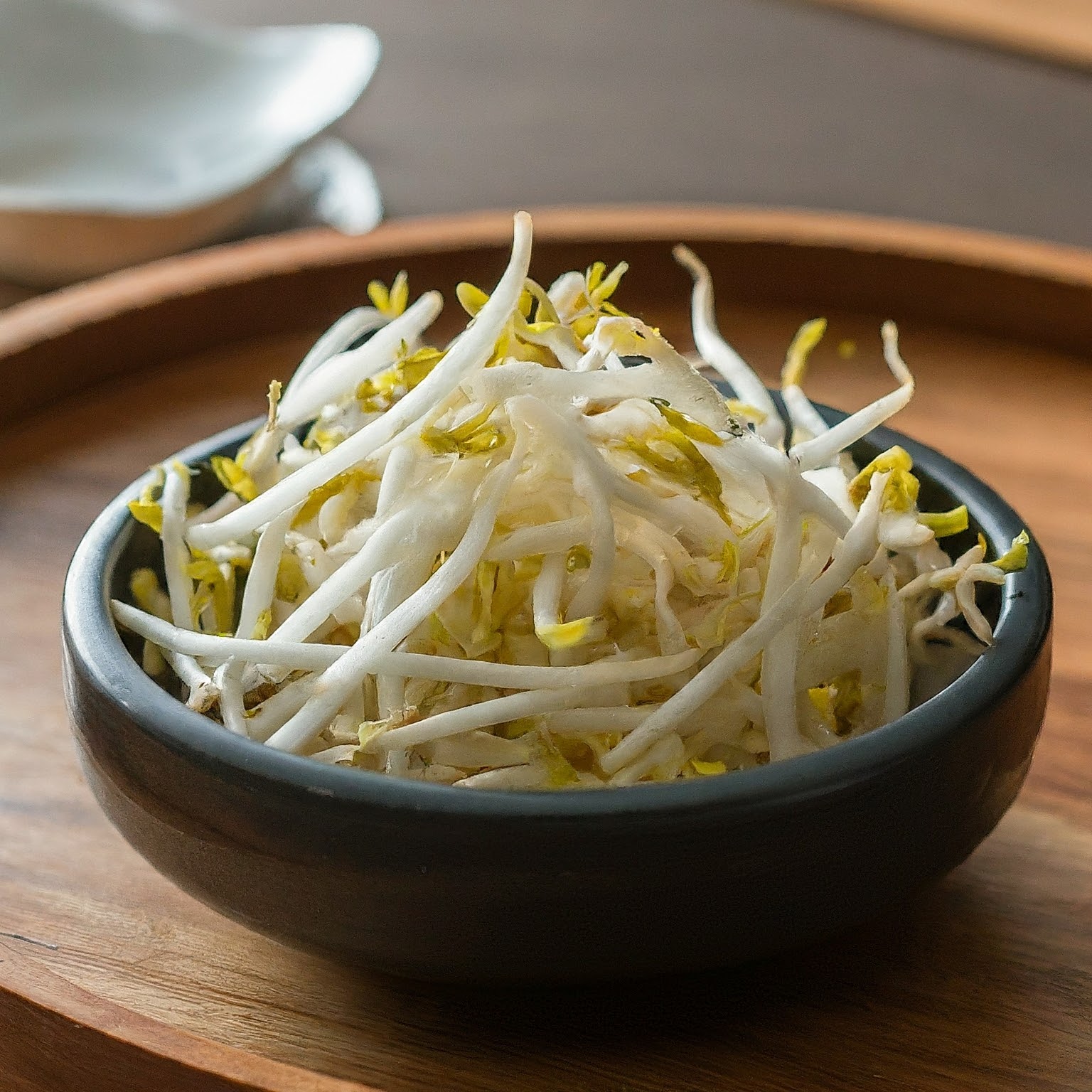Hey there, I’m Austin, and I’m excited to introduce you to a special recipe from my collection, Beyond the Bayou.
As a kid, I grew up in a household where we had a small garden, and my mom loved experimenting with different vegetables. One summer, she decided to grow bean sprouts indoors, and I vividly remember being captivated by the process of those tiny seeds turning into crunchy sprouts.
Every day, my mom would diligently care for them, ensuring they had the right amount of water and sunlight. She often incorporated them into dishes like her Bean Sprout Stir-Fry, a simple yet delicious meal that brought our family together around the dinner table.
Those memories of family, gardening, and home-cooked meals are incredibly special to me. Now, I’m thrilled to share this recipe with you. Let’s dive into the world of bean sprouts and create something wonderful together!
What Is Bean Sprout?
Bean sprouts are young shoots that grow from germinated beans or seeds. They are commonly used in various cuisines worldwide and are known for their crunchy texture and mild, slightly nutty flavor. Bean sprouts are often used fresh in salads, stir-fries, soups, and sandwiches, adding a refreshing and nutritious element to dishes. They are particularly popular in Asian cuisine, where they are frequently found in dishes like stir-fried noodles, spring rolls, and soups.
Bean sprouts are also valued for their nutritional benefits, as they are low in calories and fat while being rich in vitamins, minerals, and antioxidants. Common types of bean sprouts include mung bean sprouts and soybean sprouts, although other types of beans and seeds can also be sprouted for culinary use. This is usually eaten with Kimchi Fried Rice.
Types Of Bean Sprouts Around The World!
- Mung Bean Sprouts: These are perhaps the most widely recognized type of bean sprouts. They are commonly used in Asian cuisine, particularly in dishes from China, Korea, and Southeast Asia. Mung bean sprouts are crisp and slightly sweet, making them versatile for stir-fries, soups, salads, and spring rolls.
- Soybean Sprouts: Soybean sprouts, also known as soy sprouts, are another popular type, especially in Korean cuisine. They have a firmer texture and a nuttier flavor compared to mung bean sprouts. Soybean sprouts are often blanched before being used in dishes like bibimbap, soups, and stews.
- Alfalfa Sprouts: These sprouts come from alfalfa seeds and are commonly used in Western cuisines, particularly in salads, sandwiches, and wraps. Alfalfa sprouts have a delicate, mild flavor and a tender texture, adding a fresh crunch to dishes.
- Radish Sprouts: These sprouts come from radish seeds and are often used in Japanese cuisine. They have a slightly spicy flavor and are commonly added to sushi rolls, salads, and garnishes for soups and noodle dishes.
- Lentil Sprouts: Lentil sprouts are made from germinated lentil seeds and are popular in Middle Eastern and Indian cuisines. They have a nutty flavor and are used in salads, curries, and vegetarian dishes.
- Adzuki Bean Sprouts: Adzuki bean sprouts come from adzuki beans and are commonly used in Asian cuisine, particularly in China and Japan. They have a slightly sweet taste and are used in stir-fries, soups, and salads.
Overview: How To Make Bean Sprouts?

First, you’ll need to choose the type of beans or seeds you want to sprout. Popular choices include mung beans, soybeans, lentils, alfalfa seeds, and radish seeds.
Start by rinsing the beans or seeds under cold water to remove any dirt or debris. Then, place them in a clean container or jar and cover them with water. Let them soak for several hours or overnight to hydrate and soften.
After soaking, drain the beans or seeds and rinse them again. Transfer them to a clean, shallow container or a sprouting tray. Spread them out in an even layer, making sure they’re not too crowded.
Place the container or tray in a warm, well-ventilated area, away from direct sunlight. You can cover the beans with a clean cloth or lid to keep them moist and prevent contamination.
Over the next few days, rinse the beans or seeds twice a day with fresh water. This helps to keep them hydrated and removes any excess starch or residue.
As you continue to rinse the beans, you’ll start to see tiny sprouts emerging from the seeds. Depending on the type of beans or seeds you’re sprouting, this process can take anywhere from a few days to a week or more.
Once the sprouts have reached your desired length, usually about 1-2 inches, they’re ready to be harvested. Give them one final rinse to remove any remaining hulls or debris, then drain them well.
Your fresh bean sprouts are now ready to be enjoyed in salads, stir-fries, sandwiches, or any other dish you like. Store them in the refrigerator in a clean, airtight container for up to a week.
That’s it! With just a little bit of time and attention, you can easily grow your own bean sprouts at home and enjoy their crisp, nutritious goodness in your favorite meals. Along with this tasty side dish usually, people prefer to have Fried Crab Legs as well!
Brilliant Beans Sprouts Recipe
Equipment
- 1 Large skillet or wok
- 1 Mixing Bowl
- 1 Cutting Board
- 1 Knife
Ingredients
- 400 g about 14 oz soybean sprouts (Kongnamul)
- 2 cloves garlic minced
- 2 green onions thinly sliced
- 1 tablespoon sesame oil
- 1 tablespoon soy sauce
- 1 tablespoon toasted sesame seeds
- 1 teaspoon sugar optional
- 1 teaspoon gochugaru Korean red pepper flakes, adjust to taste
- Salt to taste
Instructions
- Rinse the soybean sprouts under cold water and remove any discolored or wilted sprouts.
- Bring a pot of water to a boil. Add the bean sprouts and cook for about 3-5 minutes until they’re just tender but still crunchy.
- Drain the bean sprouts and rinse them under cold water to stop the cooking process. Drain well and transfer them to a mixing bowl.
- Add minced garlic, sliced green onions, sesame oil, soy sauce, toasted sesame seeds, sugar (if using), gochugaru, and a pinch of salt to the bean sprouts.
- Gently toss everything together until the bean sprouts are evenly coated with the seasoning.
- Taste and adjust the seasoning according to your preference, adding more soy sauce, sesame oil, or gochugaru as needed.
- Serve the Korean bean sprout salad immediately or refrigerate it for later. Enjoy as a side dish or as part of a Korean-inspired meal!
Notes
- Adjust Seasonings: Feel free to adjust the seasonings to suit your taste preferences. You can add more or less garlic, soy sauce, sesame oil, or Korean red pepper flakes (gochugaru) based on your preference for flavor and spice level.
- Optional Sugar: The addition of sugar is optional and can be omitted if you prefer a less sweet dish. Adjust the amount of sugar to your liking or omit it altogether if you prefer.
- Customize with Vegetables: This recipe is versatile, and you can customize it by adding other vegetables like blanched spinach, shredded carrots, or sliced cucumbers for added color and flavor.
- Serve Chilled or Warm: This Korean bean sprout salad can be served chilled or at room temperature, depending on your preference. It’s refreshing when served cold but can also be enjoyed warm if you prefer.
- Make-Ahead Option: You can prepare this salad in advance and store it in the refrigerator for up to 2-3 days. The flavors will continue to develop over time, making it even more delicious.
- Garnish Ideas: Garnish the bean sprout salad with additional toasted sesame seeds, sliced green onions, or a drizzle of sesame oil before serving for an extra pop of flavor and visual appeal.
- Use Fresh Bean Sprouts: For the best texture and flavor, use fresh bean sprouts that are crisp and have a vibrant color. Avoid using bean sprouts that are limp or discolored.
- Gluten-Free Option: If you’re following a gluten-free diet, make sure to use gluten-free soy sauce to keep the recipe gluten-free.
- Serve as a Side or Main Dish: This bean sprout salad can be served as a refreshing side dish alongside Korean BBQ, rice, or other Korean dishes. It can also be enjoyed as a light and healthy main dish on its own.
Nutrition
More Recipes to Try!
Possible Variations With The Recipe?
- Spicy Variation: Add extra Korean red pepper flakes (gochugaru) or include finely chopped fresh red chili peppers for a spicier kick.
- Protein Boost: Incorporate cooked protein such as grilled chicken, beef, or tofu to make the salad more filling and satisfying.
- Seafood Addition: Mix in cooked shrimp, crab meat, or chopped squid for a seafood twist on the salad.
- Vegan/Vegetarian Option: Omit the optional sugar or replace it with a vegan-friendly sweetener like maple syrup. Ensure the soy sauce used is vegan-friendly or substitute it with tamari.
- Nutty Flavor: Enhance the nutty flavor by adding crushed roasted peanuts or toasted pine nuts to the salad.
- Citrus Zest: Add a burst of freshness with a squeeze of lime or lemon juice and some grated citrus zest.
- Herb Infusion: Mix in chopped fresh herbs such as cilantro, Thai basil, or mint to add a burst of herbal flavor and aroma.
- Asian-Inspired Dressing: Create an Asian-inspired dressing using ingredients like rice vinegar, mirin, ginger, and a touch of honey or agave syrup.
- Sesame Ginger Variation: Combine sesame oil, grated ginger, soy sauce, and a splash of rice vinegar to create a flavorful dressing with a hint of tanginess.
- Pickled Vegetables: Include pickled vegetables like daikon radish or cucumber for added tanginess and crunch.
Tips & Tricks!

1. Fresh Bean Sprouts: Use fresh bean sprouts for the best flavor and texture. Look for sprouts that are crisp and vibrant in color, with no signs of wilting or discoloration.
2. Proper Cooking Time: Be careful not to overcook the bean sprouts when blanching them. They should be tender yet still crunchy. Overcooking can result in mushy sprouts, which will affect the texture of the salad.
3. Quick Chilling: After blanching the bean sprouts, immediately transfer them to a bowl of ice water to stop the cooking process and preserve their crispness. This will also help to retain their bright green color.
4. Seasoning Balance: Taste and adjust the seasoning of the salad according to your preference. Balance the flavors of soy sauce, sesame oil, garlic, and Korean red pepper flakes (gochugaru) to achieve the perfect blend of savory, nutty, and spicy flavors.
5. Marinating Time: Allow the bean sprouts to marinate in the seasoning mixture for at least 15-30 minutes before serving. This will allow the flavors to meld together and infuse the sprouts with deliciousness.
6. Toast Sesame Seeds: Toasting sesame seeds enhances their nutty flavor and adds a crunchy texture to the salad. Toast the sesame seeds in a dry skillet over medium heat until golden brown and fragrant, then sprinkle them over the salad just before serving.
7. Make-Ahead Option: This salad can be prepared in advance and stored in the refrigerator for up to 2-3 days. However, for best results, wait to add the sesame seeds until just before serving to maintain their crunchiness.
8. Garnish Creatively: Garnish the salad with additional sliced green onions, toasted sesame seeds, or a sprinkle of finely chopped fresh herbs for a pop of color and flavor.
9. Serve at the Right Temperature: Serve the Korean bean sprout salad chilled or at room temperature, depending on your preference. It’s refreshing and delicious either way!
10. Enjoy the Leftovers: If you have leftovers, consider using them as a topping for bibimbap, adding them to stir-fries or noodle dishes, or serving them as a side dish for future meals.
What to Serve with Bean Sprouts?
Storing The Bean Sprouts!
- Refrigeration: Place the bean sprouts in a clean, airtight container or resealable plastic bag. Press out as much air as possible before sealing the container or bag.
- Moisture Control: Line the bottom of the container or bag with a paper towel to absorb any excess moisture. This helps prevent the bean sprouts from becoming soggy or developing mold.
- Temperature: Store the bean sprouts in the refrigerator at a temperature of around 40°F (4°C). Avoid storing them in the refrigerator door as the temperature may fluctuate more there.
- Use Quickly: Bean sprouts are best when consumed fresh, so try to use them within 2-3 days of purchase or sprouting for optimal flavor and texture.
- Check for Spoilage: Before using the bean sprouts, inspect them for any signs of spoilage, such as a slimy texture, off odor, or discoloration. Discard any sprouts that appear to be spoiled.
- Rinse Before Use: Before using the bean sprouts, rinse them under cold water to remove any remaining hulls or debris. Drain them well before incorporating them into your dishes.
- Freezing: While bean sprouts can be frozen, their texture may become mushy when thawed. If you plan to freeze them, blanch them in boiling water for a brief moment, then plunge them into ice water to stop the cooking process. Pat them dry and place them in freezer-safe bags or containers. Use frozen bean sprouts within a few months for best quality.
Frequently Asked Questions (FAQs)
Q: Are bean sprouts nutritious?
A: Yes, bean sprouts are nutritious. They are low in calories and fat but rich in vitamins (such as vitamin C and vitamin K), minerals (like potassium and manganese), and dietary fiber. They also contain antioxidants and enzymes that may offer health benefits.
Q: Can you eat bean sprouts raw?
A: Yes, bean sprouts can be eaten raw. They have a crisp texture and mild, slightly nutty flavor, making them a popular addition to salads, sandwiches, and wraps. However, it’s essential to rinse them thoroughly under cold water before consuming them to remove any bacteria or debris.
Q: Are there any safety concerns with eating bean sprouts?
A: There have been occasional outbreaks of foodborne illness associated with raw bean sprouts due to bacterial contamination. To reduce the risk of illness, it’s essential to purchase fresh bean sprouts from reputable sources, thoroughly rinse them before consuming, and refrigerate them promptly.

